Matinée (Jaime Humberto Hermosillo, 1977)
Aug
19
free candy
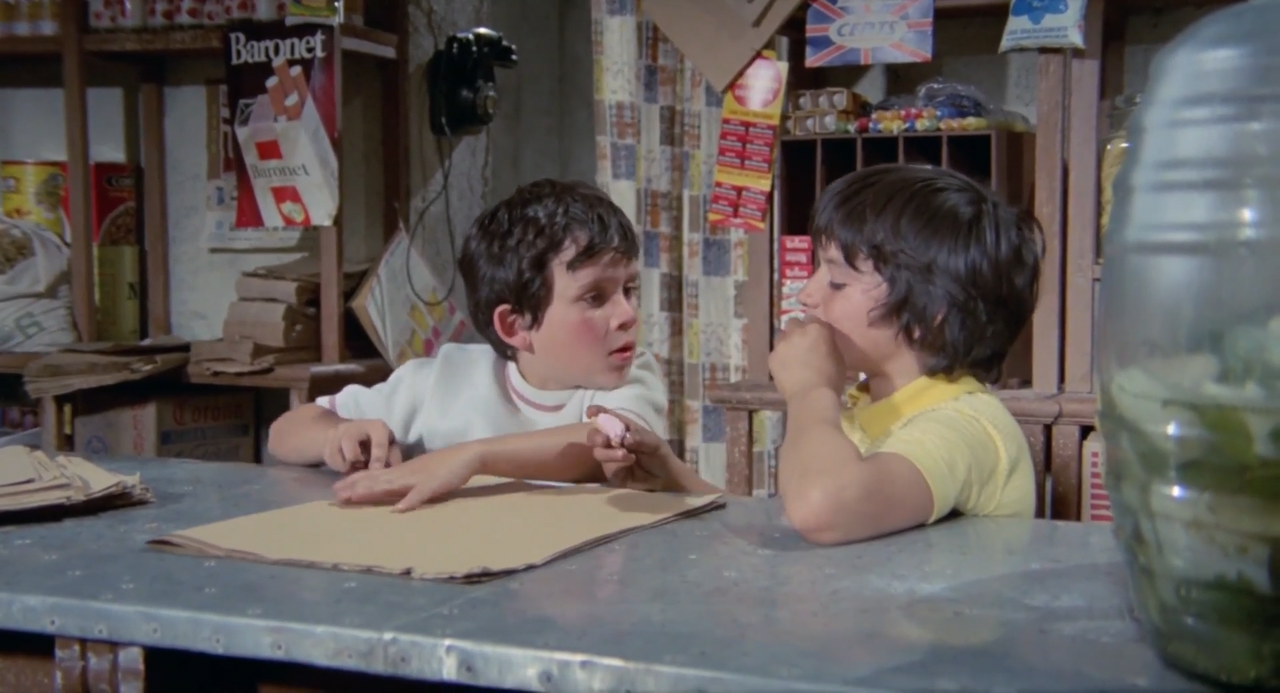
Best friends Aarón (Rodolfo Chávez Martínez) and Jorge (Armando Martín) helping out in Aarón's parents' convenience store while helping themselves to a snack or two. DP: Jorge Stahl Jr..
“I could have made mashed potatoes, but we're having that tomorrow.”Jeanne Dielman, 23 quai du Commerce, 1080 Bruxelles (Chantal Akerman, 1975)
Aug
19
National Potato Day
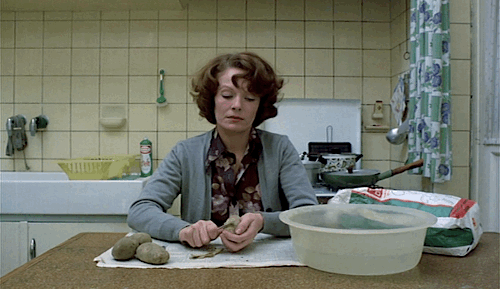
Jeanne Dielman (Delphine Seyrig) eternally peeling potatoes for dinner in this gif from Fondation Chantal Akerman. DP: Babette Mangolte.
Jeanne Dielman routinely prepares meals, cleans the house, mothers her teenage son, and entertains men. Then something breaks and her carefully nurtured practices slowly unravel.
– Jeanne Dielman
Vražda ing. Čerta [The Murder of Mr. Devil / Killing the Devil] (Ester Krumbachová, 1970)
Aug
18
Serendipity Day

Ona (Jiřina Bohdalová) is her wonderful kitchen, smoking two well-deserved cigars. DP: Jiří Macák.
Ester Krumbachová's feminist farce is a delight of many flavours. Ona (Jiřina Bohdalová) is already 40 and in need of a man. She remembers one from her youth, the handsome, slim, and very cultured Eng. Bohouš Čerta (litt. “God the Devil, Engineer”, played by the always great Vladimír Menšík), and knows that the one way to a man's heart is through the stomach.
Her cooking is immaculate. So are her looks and her apartment (all created by one-time director Krumbachová who worked as a costume designer and screenwriter). Unfortunately, her beau has turned boorish and stuffs his face with all but her and the furniture (is that true?). But cooking she can, and wanting she does. So she cooks and cooks and cooks up some more.
“Love your neighbour”Neighbours (Norman McLaren, 1952)
Aug
17
Neighbor Night

Neighbour on the Left (Jean Paul Ladouceur) and Neighbour on the Right (Grant Munro) upon discovering a small flower growing right on their properties' border. Two colourful, almost identical deckchairs can be seen on the lawn in the front and two cardboard façades of almost identical houses in the back. Both men wear almost identical beige slacks and blue shirts and sport a very similar hairstyle. DP: Wolf Koenig.
Norman McLaren's low-budget pixelation (animation created with live action footage) was groundbreaking in many aspects; even the soundtrack was painted directly onto the film stock.
– title card
Read more about its fascinating backstory and watch the short animation over at the National Film Board of Canada's website.
– What do you want from this house?
– Want?
– Yes. Want.
– I'm just the servant, miss.
– Get my lunch.The Servant (Joseph Losey, 1963)
Aug
16
National Authenticity Day

Manservant Barrett (Dirk Bogarde) and his master Tony (James Fox). Tony is asleep in a folding chair wearing an overcoat in a sparse room with crumbling walls. Barrett – immaculately dressed in a dark overcoat, hat, gloves, tie – stands in the doorway, looking down on the sleeping man. DP: Douglas Slocombe.
Maléfices [Where the Truth Lies] (Henri Decoin, 1962)
Aug
16
milk

Ronga (Maîthé Mansoura accompanied by cheetah Nyète), sits on a straw-covered floor while holding a bowl with milk. There are potted plants and gardening equipment is placed against the wall. DP: Marcel Grignon.
“You and I may dream of gold or grocery bills — but when a child slaps Morpheus on the back and says 'Hello, old man' — well it's a different story.”Moonland (William A. O'Connor, 1926)
Aug
15
Chant At The Moon Day

Mickey (Mickey McBan) and his dog looking up to the crescent moon from a perfectly round window with beaded curtains made of stars. Spot the Milky Way! DP: Edward Gheller.
A little boy and his dog are invited over by the Man in the Moon himself. The trip to the Moon is a big adventure for the drowsy duo and they meet peculiar flora, fauna and men along the way, lifted straight from the Great Moon Hoax.
– opening title card
Post-McCay's serial Little Nemo in Slumberland (1905) and pre-Fleming & Cukor's The Wizard of Oz (1939), William A. O'Connor is heavily indebted to both. Which doesn't make his short Art Deco-styled science fiction fantasy any less magical.
– Does he crawl on four legs? What does he eat and drink? – I've given him water to drink on occasion. He would never eat me.La Belle et la Bête [Beauty and the Beast] (Jean Cocteau + René Clément, 1946)
Aug
15
a cornucopia of wonder
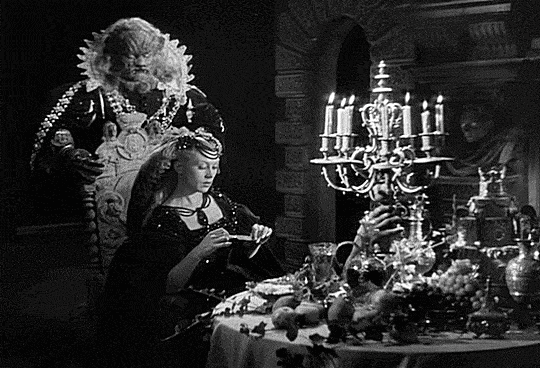
La Belle (Josette Day) at a fancy table stacked with good foods and nice wines. She's cleaning her fingernails with the silverware while a chagrined Bête (Jean Marais) looks on. As magical as the story are the production and set design by Christian Bérard, Lucien Carré, and René Moulaert. They breathed a soul into almost everything, including the candelabras. DP: Henri Alekan.
Les créatures [The Creatures] (Agnès Varda, 1966)
Aug
14
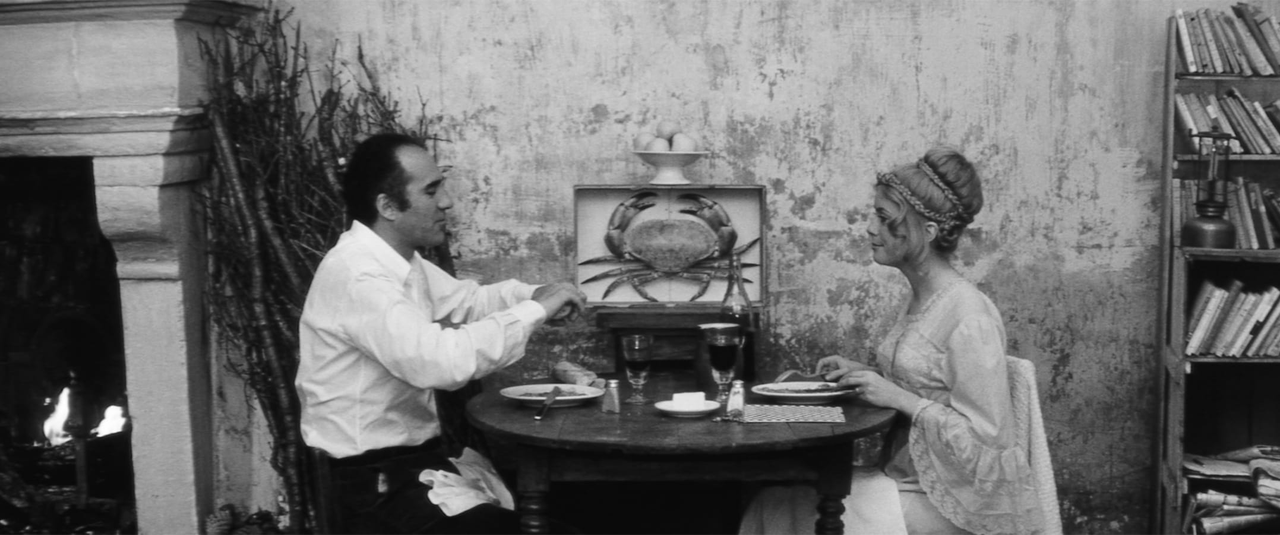
Edgar (Michel Piccoli) and Mylène (Catherine Deneuve) all dressed up for a home-cooked meal. On the wall behind them a huge framed mounted crab. DPs: Willy Kurant, William Lubtchansky & Jean Orjollet.
新宿泥棒日記 [Shinjuku Dorobō Nikki / Diary of a Shinjuku Thief] (Nagisa Ōshima, 1969)
Aug
14
Love Your Bookshop Day
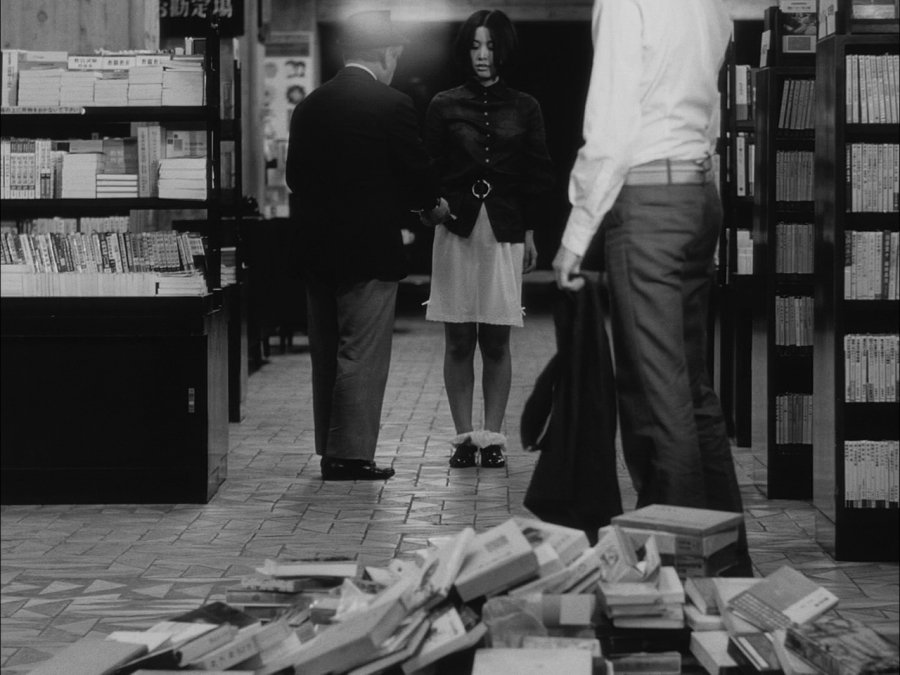
Umeko (Rie Yokoyama) in a bookstore. In the foreground a large messy pile of books. DPs: Seizō Sengen & Yasuhiro Yoshioka.
Umeko (Rie Yokoyama) believes to have caught Torio redhanded (Tadanori Yokoo, whose character has been renamed “Birdey” in the English translation), shoplifting from her bookstore. Torio however is a performance actor – and real-world Art Theatre Guild performer – and the act of stealing is part of his research. The young people's encounter sets something in motion. Together them embark on committing crimes in #Tokyo's labyrinthine #Shinjuku neighbourhood and find their mirror images in a #kabuki play.
新宿泥棒日記 is a playful, dangerous exploration of youth and rebellion in a rapidly shifting Japan.